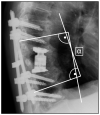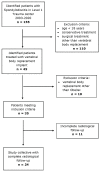Anterior Column Reconstruction of Destructive Vertebral Osteomyelitis at the Thoracolumbar Spine with an Expandable Vertebral Body Replacement Implant: A Retrospective, Monocentric Radiological Cohort Analysis of 24 Cases
- PMID: 38202303
- PMCID: PMC10780050
- DOI: 10.3390/jcm13010296
Anterior Column Reconstruction of Destructive Vertebral Osteomyelitis at the Thoracolumbar Spine with an Expandable Vertebral Body Replacement Implant: A Retrospective, Monocentric Radiological Cohort Analysis of 24 Cases
Abstract
Background: Vertebral osteomyelitis (VO) often necessitates surgical intervention due to bone loss-induced spinal instability. Anterior column reconstruction, utilizing expandable vertebral body replacement (VBR) implants, is a recognized approach to restore stability and prevent neurological compromise. Despite various techniques, clinical evidence regarding the safety and efficacy of these implants in VO remains limited.
Methods: A retrospective cohort analysis, spanning 2000 to 2020, was conducted on 24 destructive VO cases at a Level 1 orthopedic trauma center. Diagnosis relied on clinical, radiological, and microbiological criteria. Patient demographics, clinical presentation, surgical interventions, and radiological outcomes were assessed.
Results: The study included 24 patients (62.5% male; mean age 65.6 ± 35.0 years), with 58% having healthcare-associated infections (HAVO). The mean radiological follow-up was 137.2 ± 161.7 weeks. Surgical intervention significantly improved the bi-segmental kyphotic endplate angle (BKA) postoperatively (mean -1.4° ± 13.6°). However, a noticeable loss of correction was observed over time. The study reported a mortality rate of 1/24.
Conclusions: Anterior column reconstruction using expandable VBR effectively improved local spinal alignment in destructive VO. However, the study underscores the necessity for prolonged follow-up and continuous research to refine surgical techniques and postoperative care. Addressing long-term complications and refining surgical approaches will be pivotal as the field progresses.
Keywords: anterior column reconstruction; bony fusion rate; expandable vertebral body replacement; spondylodiscitis; vertebral osteomyelitis.
Conflict of interest statement
The authors declare no conflicts of interest.
Figures




Similar articles
-
Radiological and mid- to long-term patient-reported outcome after stabilization of traumatic thoraco-lumbar spinal fractures using an expandable vertebral body replacement implant.BMC Musculoskelet Disord. 2021 Aug 30;22(1):744. doi: 10.1186/s12891-021-04585-y. BMC Musculoskelet Disord. 2021. PMID: 34461863 Free PMC article.
-
Early versus delayed corpectomy in thoracic and lumbar spine trauma. A long-term clinical and radiological retrospective study.Orthop Traumatol Surg Res. 2020 Apr;106(2):261-267. doi: 10.1016/j.otsr.2018.11.019. Epub 2019 Feb 11. Orthop Traumatol Surg Res. 2020. PMID: 30765308
-
[Operative treatment of traumatic fractures of the thoracic and lumbar spinal column: Part III: Follow up data].Unfallchirurg. 2009 Mar;112(3):294-316. doi: 10.1007/s00113-008-1539-0. Unfallchirurg. 2009. PMID: 19277756 Clinical Trial. German.
-
Vertebral body replacement with an expandable cage for reconstruction after spinal tumor resection.Neurosurg Focus. 2003 Nov 15;15(5):E8. doi: 10.3171/foc.2003.15.5.8. Neurosurg Focus. 2003. PMID: 15323465 Review.
-
Isolated unstable burst fractures of the fifth lumbar vertebra: functional and radiological outcome after posterior stabilization with reconstruction of the anterior column: About 6 cases and literature review.Orthop Traumatol Surg Res. 2020 Oct;106(6):1215-1220. doi: 10.1016/j.otsr.2020.03.014. Epub 2020 Apr 27. Orthop Traumatol Surg Res. 2020. PMID: 32354682 Review.
Cited by
-
Medical versus surgical treatment of spondylodiscitis: does surgery spare resources?Neurosurg Rev. 2025 Mar 31;48(1):340. doi: 10.1007/s10143-025-03503-3. Neurosurg Rev. 2025. PMID: 40159536
-
Treatment of thoracolumbar fractures with severe collapse of the anterior and middle columns via balloon-assisted endplate reduction, transpedicular bone grafting and pedicle screw fixation.J Orthop Surg Res. 2025 Jun 10;20(1):580. doi: 10.1186/s13018-025-05916-8. J Orthop Surg Res. 2025. PMID: 40490813 Free PMC article.
References
-
- Lang S., Walter N., Schindler M., Baertl S., Szymski D., Loibl M., Alt V., Rupp M. The Epidemiology of Spondylodiscitis in Germany: A Descriptive Report of Incidence Rates, Pathogens, In-Hospital Mortality, and Hospital Stays between 2010 and 2020. J. Clin. Med. 2023;12:3373. doi: 10.3390/jcm12103373. - DOI - PMC - PubMed
-
- Schömig F., Li Z., Perka L., Vu-Han T.-L., Diekhoff T., Fisher C.G., Pumberger M. Georg schmorl prize of the German spine society (DWG) 2021: Spinal Instability Spondylodiscitis Score (SISS)—A novel classification system for spinal instability in spontaneous spondylodiscitis. Eur. Spine J. 2022;31:1099–1106. doi: 10.1007/s00586-022-07157-3. - DOI - PubMed
-
- Taylor D.G., Buchholz A.L., Sure D.R., Buell T.J., Nguyen J.H., Chen C.-J., Diamond J.M., Washburn P.A., Harrop J., Shaffrey C.I., et al. Presentation and Outcomes After Medical and Surgical Treatment Versus Medical Treatment Alone of Spontaneous Infectious Spondylodiscitis: A Systematic Literature Review and Meta-Analysis. Glob. Spine J. 2018;8:49S–58S. doi: 10.1177/2192568218799058. - DOI - PMC - PubMed
LinkOut - more resources
Full Text Sources

